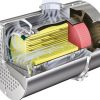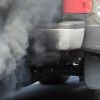To address this, the European Union decided to introduce a new test regime, designed to measure fuel consumption and CO2 emissions more accurately than the previous system,
The Worldwide Harmonised Light Vehicle Test Procedure (WLTP) laboratory test, introduced in 2017, replaced the previous outdated lab test – known as the New European Driving Cycle (NEDC) – which came into use in the 1980s.
The old test attracted much criticism due to claimed fuel consumption figures from manufacturers often being very different to those experienced by drivers in the real world.
While the new test is still laboratory-based, it uses real driving data gathered from around the world so that it better matches what you'd achieve on the road. It is important to note that there is a direct link between the amount of CO2 a car emits and the amount of fuel it uses, or its fuel economy.
What is WLTP?
WLTP is intended to allow different regions across the world to compare pollutant and CO2 emissions as well as fuel consumption values. But while it has a common global ‘core’, the EU and other regions will use the test in different ways depending on their road traffic laws and needs.
Even though the latest test is a more realistic representation of conditions encountered on the road than the old one, on-road performance can still be different due to individual driving styles which can vary considerably. For example, some drivers accelerate faster and brake more heavily than others.
- Euro 1 to Euro 6 video guide – find out your vehicle's emissions standard
- How to save fuel - the ultimate guide
Naturally, emissions will also differ in the real world for the same reason as well as variations in traffic volumes and weather conditions, but the differences will be smaller.
The more realistic testing conditions included in WLTP are:
- Higher average and maximum speeds
- A wider range of driving situations (urban, suburban, main road and motorway)
- More realistic acceleration and deceleration
- Higher average and maximum drive power
- Longer test distances
- More realistic ambient temperatures closer to the European average
- Testing with optional equipment, such as bigger wheels
Here's a comparison of the old test (New European Driving Cycle - NEDC) and the latest Worldwide Harmonised Light Vehicle Test Procedure (WLTP).
| Old test / New European Driving Cycle (NEDC) | New test / Worldwide Harmonised Light Vehicle Test Procedure (WLTP) | |
|---|---|---|
| Test cycle | Single test cycle | Dynamic test cycle more representative of real driving |
| Cycle time | 20mins | 30mins |
| Cycle distance | 11km/7 miles | 23.25km/14 miles |
| Driving phases | 2 phases – 66% urban, 34% non-urban | 4 more dynamic phases – 52% urban, 48% non-urban |
| Average speed | 34kph/21mph | 46.5kph/29mph |
| Maximum speed | 120kph/74.5mph | 131kph/81mph |
| Influence of optional equipment | Impact on CO2 and fuel performance not considered | Additional features (which can differ per car) are taken into account |
| Gear shifts | Vehicles have fixed gear shift points | Different gear shift points for each vehicle |
| Test temperatures | Measurements at 20-30°C | Measurements at 23°C, CO2 values corrected to 14°C |
When did WLTP first apply?
WLTP officially applied to new types of cars launched from September 2017, but it was not until September 2018 that it applied to all new car registrations. Vehicles previously tested under the old NEDC system but in unsold stock were allowed to be sold until September 2019.
As the new test is more rigorous when testing emissions, many cars have higher quoted CO2 figures than they did previously, raising the car tax liability - though that only affects the first-year tax rate built into the purchase price.
It is important to note that any changes made only affected new vehicles being registered for the first time in the above dates, and not existing vehicles.
The EU has also introduced a new test that measures all types of vehicle exhaust emissions, such as nitrogen dioxide (NO2), emitted by cars when they are being driven on the road. Nitrogen oxide (NOx) emissions are often linked to poor air quality which can blight many urban areas.

RAC sale – up to 33% off*
• Roadside cover from £5.29 a month†
• We get to most breakdowns in 60 mins or less
• Our patrols fix 4/5 breakdowns on the spot

What is The Real Driving Emissions (RDE) test?
The Real Driving Emissions (RDE) test is designed to complement the WLTP laboratory test. It ensures cars deliver the correct level of emissions in on-road conditions and is a world-first.
The test involves cars being driven on public roads over a wide range of different conditions. Specialist testing equipment is installed to gather data to verify that legislative limits for pollutants such as NOx are not exceeded.
The test conditions include:
- Low and high altitudes
- Year-round temperatures
- Additional vehicle payload
- Uphill and downhill driving
- Urban roads (low speed)
- Rural roads (medium speed)
- Motorways (high speed)
RDE became mandatory for all new cars in September 2019. From January 2020 the level of NOx emissions allowed was tightened, but this did not apply to all new cars until January 2021.
Did you know, you can get fined for moving out of the way of an ambulance?
Want more useful content like this sent straight to your inbox?






